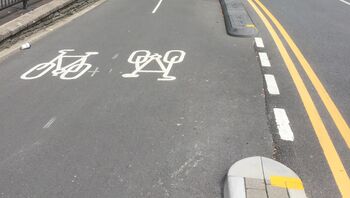Template:Ar:Map Features:cycleway
Jump to navigation
Jump to search
طريق للدراجات
| القيمة | العنصر | وصف | صورة | |||
|---|---|---|---|---|---|---|
Dedicated bicycle lanes | ||||||
lane
|
طريق الدراجات هو مسار يتبع طريق العربات. |  | ||||
|
| ||||||
shared_lane
|
Cyclists share a lane with motor vehicles, and there are markings (like The road markings are usually there to highlight a cycle route or to remind drivers that you can cycle there. |
 | ||||
share_busway
|
A special lane reserved for public transport on which cyclists are also allowed to bike. |  | ||||
Bicycle tracks | ||||||
track
|
طريق الدراجات هو مسلك بعيد و منفصل عن طريق العربات. |  | ||||
separate
|
Should be used to indicate that a cycle track associated with a highway has been mapped as a separate OSM element (i.e., is tagged with highway=cycleway). Meaning is similar to the use of sidewalk=separate for footways, and can potentially be used when simplifying geometries for rendering. It also acts as a hint to avoid duplicating an existing cycleway by adding cycleway=track to a highway. Don't confuse with segregated=yes.
|
|||||
No bicycle infrastructure | ||||||
no
|
Explicitly marks that a street has no bicycle infrastructure. This allows to explicitly note that the road was surveyed for bicycle infrastructure. |  | ||||
Other bicycle infrastructure | ||||||
crossing
|
Used on separately mapped paths to indicate that it's a bicycle crossing. |  | ||||
shoulder
|
Used to indicate that a road has no designated infrastructure for cyclists, but shoulders (a.k.a. breakdown lanes) are navigable and legal to cycle on. Especially on rural roads with high speed limits, the existence of a shoulder usable by cyclists can make the difference whether the road is usable at all (semi-)safely for cyclists. Not every shoulder=* is automatically usable for cyclists: Some shoulders are used for parking (parking=shoulder) instead, not all shoulders are paved (with asphalt, e.g. grass pavers). Additionally, shoulder=yes is typically only mapped for shoulders that are broad enough to accommodate a car. For cyclists however, a less wide shoulder is fine, too.
|
 | ||||
link
|
A connector between OSM segments for cycle traffic, for example to connect a separately mapped cycle path to a junction on the opposite side. Serves primarily as a routing aid and does not necessarily have to be identifiable as built infrastructure. |  | ||||
traffic_island
|
Used on the parts of refugee islands of a cycleway=crossing.
|
 | ||||
asl
|
Indicates an advanced stop line or bike box at junctions. Use cycleway=asl on a direction=forward or direction=backward for an explicitly reference to the closest junction that a ASL relates to and thus the direction of traffic that it applies to.
|
 | ||||
gap_jump
|
A gap jump segment of MTB downhill route. Generally would consist of two or three parts: a take-off ramp; a physically non-existent mid-air segment; and optionally a landing ramp (if not present, a regular bike track serves as a landing zone). The mid-air segment may cross other roads or features, in which case it should be tagged with layer=1 without a node at the intersection; surface=none has occasionally been added as well. Consider explicitly providing foot=no or access=no + bicycle=designated in order to prevent routing for any other activity.
|
 | ||||
Deprecated or discouraged tags | ||||||
opposite |
السير في الإتجاه المعاكس مسموح للدراجات | |||||
shared |
Formerly used on cycleways which were mapped as separate ways tagged as highway=cycleway before the segregated=* tag was formalized. Its use with highway=cycleway is now considered obsolete.
| |||||
This table is a wiki template with a default description in English. Editable here.